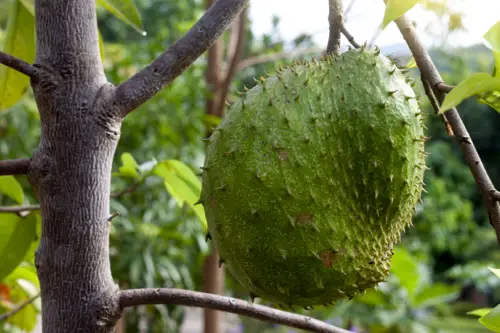If you want to know more about the soursop tree, the conditions it grows under and some interesting facts about its cultivation and use, read this post.
Origin of Soursop
It said that the soursop tree is said to have originated in South America and the Caribbean islands known as the West Indies.
Uses For Soursop
Among all of the Annona species, soursop is the most tropical.. It is the best choice for preserving and processing activities. The tree also produces the largest fruit. It has low-branches and it is shrubby. It reaches a height of approximately 8 to 10 meters (25 to 30 ft). The seeds found in the pulp of the soursop fruit and the soursop leaves have properties that are toxic to some insects. When crushed, they are are effective against head lice, southern armyworms, and pea aphids. The fruit is also used in fish traps for bait. The soursop wood could also have potential as a source for making paper pulp. It is used to make ox yokes, because it does not cause hair loss on the neck of oxen.
Soursop Cultivation
Here is some data on soursop cultivation:
Elevation: Soursop is grow from sea-level to 1200 meters (3500 ft).
Germination: It can be direct-seeded or soaked for 24 hours. It will germinate in 15 to 30 days.
Soil: The soursop tree prefers rich, well-drained soil. However it can be grown in acidic and sandy soil.
Temperature: The soursop tree is very cold-sensitive and will suffer injury in a light frost. The tree thrives in tropical climate and temperatures.
Propagation: Soursop is often propagated by seed. It will produce fruit in 3 to 5 years. It requires plenty of sun and cannot withstand strong winds. Soursop trees took a beating in the Virgin Islands when they were hit by hurricanes in 2017.
Grafting: When choosing a grafting strategy, it is best to use soursop seedlings. However, grafting onto custard apple, mountain soursop, or pond apple is known to be successful.
Soursop Harvesting and Seed Production
Soursop tree flowers continuously, but in each growing region, there is one principal harvest period. Soursop fruit is picked when it is fully grown and while it is still firm, but slightly yellow-green. If the fruit is allowed to soften on the tree, it will fall to the ground and be ruined. The soursop bears 12 to 20 units of fruit per tree.
Soursop Susceptibility To Pests and Disease
Soursop tree is attacked by a variety of pests, that vary by region where it grows. Mealybugs may occur enmass on the fruit, while scale and lacewings infest the tree. The fruit is attacked by fruit flies. Red spider mites are a problem in dry climates. Defoliator caterpillars can be a problem on soursop trees. Also be alert for anthracnose disease on the fruit.
Cooking Soursop, and Nutrition
Soursop fruit is classified as sweet, sub-acid, or acid. The fruit is best eaten 5 to 6 days post harvest. Cut the fruit into sections and eat the flesh with a spoon or off the rind. It can be added to fruit salad. It can also be served with sugar and milk.
The most common use for the fruit in the tropics, however, is as a blended drink.
In Fruits of Warm Climates, byJulia Morton, the following directions can be used to prepare a soursop beverage:
- Remove the seeds from the pulp.
- Press the seeded pulp in a colander to extract the rich, creamy juice,
- Beaten with milk or water.
- Sweeten with sugar to tastes.
Here is another preparation:
- Remove all seeds before blending the pulp as they are toxic and should not be eaten in any quantity.
- Blend the seeded pulp with an equal amount of boiling water.
- Strain it.
- Sweeten to taste.
A soursop custard is made in the Dominican Republic as follows: Cook soursop pulp in a sugar syrup with cinnamon and lemon peel.
Soursop ice cream is also popular. To create this:
- Mash the pulp in water.
- Let it stand, then strain to remove fibers and seeds.
- Blend the liquid with sweetened condensed milk.
- Pour it into ice cube trays.
- Stir several times while it freezes.
Immature soursop fruit can also be roasted, fried, cooked as vegetables, or used in soup.

